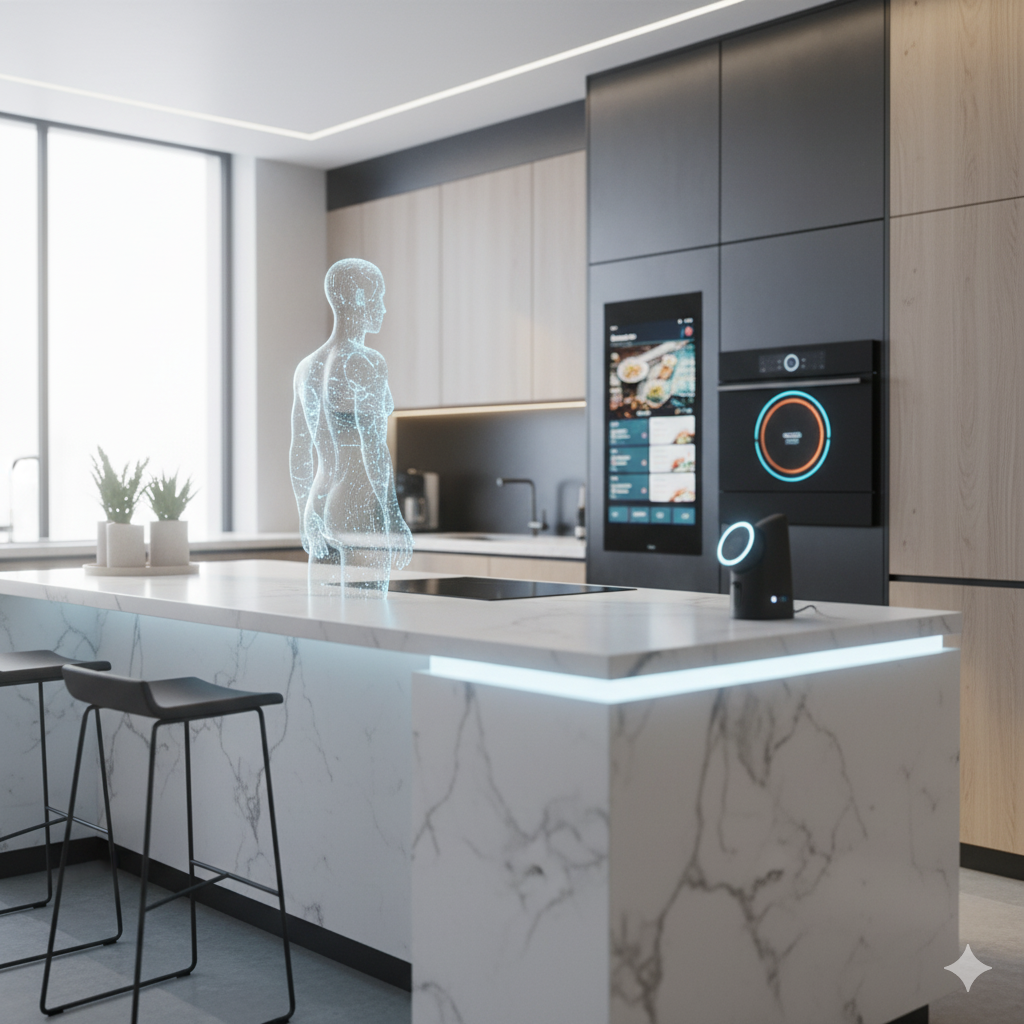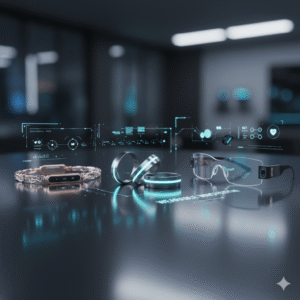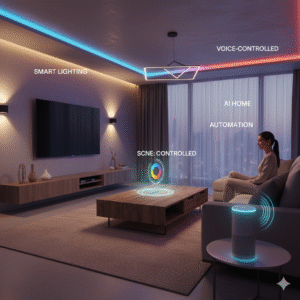Spatial Audio & Next-Gen Earbuds — going beyond noise-cancellation
1. What is Spatial Audio?
Spatial audio refers to technology that simulates or reproduces sound in three dimensions — not just left vs. right (stereo), but depth (front/back), height (above/below), and directionality (moving with or around you).
Key components of spatial audio include:
- Binaural audio: Using two “ears” (or two channels) and modeling how real human ears receive sound, including the subtle timing, amplitude, and frequency cues that tell your brain where a sound comes from.
- Head tracking: Adjusting spatial sound when you move your head so that virtual sound sources appear stable in space (e.g. a sound in front of you stays in front when you move your head).
- Ambisonics / multichannel audio: Formats that encode sound field information in more than just two channels—allowing immersive sound mapping.
- Rendering / DSP: Processing of audio in real time to adjust based on device orientation, user movement, environment, etc.
Spatial audio can be used for music (especially in Dolby Atmos, Sony 360 Reality Audio, etc.), movies / video content, gaming, augmented reality (AR), virtual reality (VR), and other immersive experiences.
2. Why “Going Beyond Noise-Cancellation” Matters
Noise cancellation (especially Active Noise Cancellation, ANC) is great: it reduces unwanted ambient sounds, letting you focus on audio content without raising volume excessively. But ANC has its limits — and spatial audio adds new dimensions to what “good listening” means.
Here’s why spatial audio + next-gen earbuds offer more than just ANC:
- Immersion: Spatial audio can give a greater sense of being “in the scene,” whether in a movie, concert, VR/AR environment. Sounds come from directions, move with you.
- Situational awareness: Good spatial audio, combined with transparency or ambient modes, can help you stay aware of what’s happening around you, while still enjoying immersive audio.
- Better audio fidelity & detail: Certain spatial audio systems preserve or reveal detail that stereo doesn’t, especially instruments or environmental effects.
- Gaming / VR/AR compatibility: In virtual or augmented reality, spatial cues are essential for orientation, realism, and reducing disorientation or motion sickness.
- Personalization: Next-gen earbuds increasingly tailor sound to your ear shape, your listening preferences, even your typical environment. Spatial audio systems often incorporate personalization.
So, while ANC is still a key part of many premium earbuds, spatial audio pushes the experience to a new level: enhancing where and how you hear, not just how much outside sound you block.
3. Technologies Driving Next-Gen Earbuds
To deliver compelling spatial audio experiences beyond mere noise cancellation, there are several enabling technologies. Many of these are converging now in newer earbuds.
A. Spatial Audio Rendering & Head Tracking
- Dynamic binaural rendering: Not just static soundstage, but adjustments depending on head orientation and movement. If you turn your head, virtual sound sources should remain fixed in space.
- Head trackers / IMUs (Inertial Measurement Units): Gyroscopes, accelerometers inside earbuds or in connected devices help detect orientation changes.
- Room / environment calibration: Systems that take into account the acoustic characteristics of your room, reflections, etc., and adjust the spatial rendering.
- Formats and content availability: Content native in spatial / 3D / immersive formats matters; also metadata for head tracking and spatial cues. Streaming services (music / video / gaming) have been increasingly supporting spatial/immersive audio (e.g. Dolby Atmos, Apple Spatial Audio, Sony 360).
B. Microphones, Beamforming & Environmental Awareness
- Multiple microphones per bud: some both inside and outside, to detect ambient noise, wind, and user voice.
- Beamforming: Using microphone arrays to focus on sound coming from certain directions (e.g. your voice during calls) while suppressing noise from others.
- Environmental or situational adaptive features: Automatically adjusting for wind noise, when walking vs sitting, in vehicle vs open space, etc.
- Transparency / ambient mode: Letting real-world sound through selectively; spatial audio helps maintain realism of “outside” sources.
C. Codecs, Latency, Wireless Protocols
- Bluetooth versions: newer specs (Bluetooth 5.x), LE Audio, etc., that allow lower latency, better power efficiency.
- Audio codecs that support spatial audio / multichannel / higher bandwidth.
- Low latency is especially critical if you’re watching video, gaming, or using AR/VR features; delays degrade the spatial effect or cause misalignment of sound & visuals.
- Multipoint connectivity (multiple devices), syncing with video, etc.
D. AI / DSP & Personalization
- DSP techniques to simulate spatialization, to enhance clarity, to adapt for environment.
- AI / machine learning embedded (or in connected app) to learn user preferences, ear shape (via HRTF – head-related transfer functions), content types.
- Real-time adaptation: changing spatial profile based on environment, detecting distractions, etc.
- Noise cancellation enhancements via AI: separating voices from noise, semantic hearing (which target sound classes to allow, which to suppress) etc. Recent research (e.g. “Semantic Hearing”) is making strides. arXiv
E. Hardware / Battery / Ergonomics Trade-offs
- Earbud size, weight, fit: more sensors and features mean more components and power. Balancing comfort and feature density is a challenge.
- Battery life: spatial audio + head tracking + ANC consumes more power; casing design, fast charging, wireless charging, efficient circuits matter.
- Cooling / materials: especially in ANC and loud volume usage, but more so for over-ear/headphone designs. For earbuds, materials affecting acoustic performance (seal, fit, damping) are critical.
4. Comparing Noise Cancellation vs Spatial Audio: Strengths, Limits & Synergies
| Feature | Strengths of Noise Cancellation (ANC / ENC) | Strengths of Spatial Audio | Limitation / Trade-offs |
|---|---|---|---|
| Ambient noise suppression | Blocks or reduces unwanted external noise, especially low frequency and continuous sounds (traffic, engines). | Spatial audio doesn’t “block” noise per se; it adds directional immersion; can make content feel more lifelike even if some ambient remains. | ANC can introduce artifacts, pressure sensations; spatial audio may require higher processing power; if latency high, spatial effect suffers. |
| Immersion / realism | Less distraction, more focus on content. But with standard stereo, immersion is limited. | Provides depth and directional cues; sense of place; enhances movies, VR, gaming, etc. | Content needs to be formatted appropriately; head tracking must be accurate; poor rendering can break illusion. |
| Situational awareness | Usually, ANC reduces ambient sound — which is good for immersion, but bad for awareness; transparency mode helps. | Spatial audio + ambient / transparency modes can provide more realistic “real world” sound; you can locate where external sounds are coming from. | Complexity increases; user control becomes important. |
| Battery & cost | ANC requires extra mics, processing; spatial audio adds more requirements. | More components, more DSP, more sensor/encoder/decoder complexity. | Trade-off between feature richness vs cost / battery life. |
| Use cases | Frequent in commuting, noisy environments. | Best for immersive media, gaming / AR / VR, creators, content benefitting from directional sound. | A user may not always need spatial audio: some prefer simple, clean stereo plus good ANC. |
Synergies: Many modern earbuds combine both: noise cancellation for external noise, spatial audio rendering for immersive content, transparency modes for awareness when needed. Good design allows switching (or automatic switching) depending on context.
5. Examples of Earbuds & Features Pushing the Envelope
Let’s look at specific products or announcements showing where the market is heading.
- Bose QuietComfort Ultra Earbuds / QuietComfort Ultra Headphones
These feature Bose Immersive Audio, which delivers spatialized sound / a wider soundstage, combined with Bose’s world-class noise cancellation. They also support CustomTune calibration, advanced microphone arrays, adaptive filters. Bose+1 - 1MORE Aero
Among earbuds offering spatial audio with head tracking plus QuietMax ANC that blocks noise in a wide frequency range (≈ 40Hz–4000Hz). Includes multiple listening modes (adaptive, wind-noise resist, transparency) and smart loudness boosting for fidelity at lower volumes. markets.businessinsider.com - Truke Buds Mega 9 (India)
A more affordable example. These offer 24-bit spatial audio, 13 mm titanium drivers, environmental noise cancellation (ENC), stylish case. Shows spatial audio features are trickling down to more budget/mid-range tiers. The Times of India - Other manufacturers
Many brands are integrating spatial audio / immersive modes into their premium lineups. For example, Bose’s new QC Ultra line, etc. Also, tech shows like CES have revealed innovations combining spatial audio with health/wearable features. TechRadar+1
6. What to Look for When Choosing Next-Gen Earbuds
If you are shopping for earbuds and want “beyond noise cancellation,” here are the features and metrics you should compare.
- Spatial audio support & head tracking
- Does the earbud or paired device support spatial audio formats (Dolby Atmos, Sony 360, Apple Spatial Audio, etc.)?
- Does it have head tracking / orientation sensors to maintain spatial realism?
- Can it render standard stereo content in a spatialized way?
- Performance of ANC / ENC plus Transparency / Ambient mode
- How many microphones, and where are they placed (inside, outside)?
- Adaptive ANC: does the system adapt to different noise profiles (wind, urban, office)?
- How natural is transparency mode (does outside sound come through cleanly? Is it distorted / muffled?)
- Latency
- Particularly important for video content, gaming, VR/AR. Latency should be low enough not to produce noticeable lag between video and audio.
- Wireless protocols and codecs matter here (look for mention of low latency modes, updated Bluetooth versions, LE Audio, aptX Adaptive, etc.)
- Battery life
- Features like spatial audio + head tracking + ANC consume more power. Evaluate both earbuds playtime and case.
- Fast charging, wireless charging, battery case capacity.
- Fit, comfort, seal & sound signature
- Proper fit is essential both for audio fidelity (bass, spatial cues) and for ANC.
- Materials, ear tip sizes, stability bands, overall ergonomic design.
- Also, sound tuning: some brands offer EQ adjustments or profiles; others have fixed “brand” sound. Some offer personalized sound calibration (e.g. measuring acoustic response of your ear).
- App / feature ecosystem
- Companion apps often control spatial modes, allow updates, calibration, firmware improvements.
- Multi-device support, switching, companion content (e.g. streaming platforms that provide spatial audio), paired video devices or gaming/VR devices.
- Durability & real-world usability
- Water/sweat resistance (IP ratings), build quality.
- Warranty, support.
- Comfort over long usage (travel, commute, gaming sessions).
7. Use-Cases: Who Benefits Most
Different people will value spatial audio and next-gen features differently. Here are key user groups and how they benefit.
| User Type | Key Demands | How Spatial + Next-Gen Earbuds Help |
|---|---|---|
| Commuters / Travelers | Block out engine / ambient noise; clarity for calls; awareness when needed (e.g. announcements) | ANC for noise suppression; transparency mode; spatial audio for immersive music / video during journeys. Lightweight and good battery life are also crucial. |
| Gamers / VR / AR Users | Precise directional sound; low latency; head tracking; spatial cues for orientation in virtual space | Spatial audio + head tracking; low latency headphones; possibly multipoint to switch between devices; consistent rendering so sound matches visuals. |
| Audiophiles & Music Lovers | Fidelity, detail, dynamic range; immersive soundstage; accurate rendering; content in spatial formats | High-quality drivers, good codecs, spatial audio support, personalized calibration; ability to enjoy high resolution audio, 3D remastered content. |
| Creators / Content Producers | Mixing / mastering audio; need accurate spatial cues; testing spatial, immersive content | Earbuds that can reproduce spatial audio accurately; supportive tools or apps for calibration and verification; robust hardware. |
| Fitness / Outdoor Users | Secure fit; sweat/water resistance; awareness of environment for safety; good sound even during movement / wind | Adaptive ANC modes; beamforming for wind noise; transparency / ambient modes; durable, comfortable design. |
8. Emerging Research & Future Directions
The field is evolving fast. Here are several promising research directions and future possibilities.
- Semantic Hearing / Target Sound Extraction
Work is underway on systems that can selectively extract sounds of interest (voices, alarms, etc.) and preserve spatial cues while suppressing unwanted noise. Example: “Semantic Hearing” systems that classify ~20 sound classes in real time and preserve directionality even when suppressing background interference. arXiv - Spatially Selective Active Noise Control
Not just blanket suppression of noise, but suppressing noise from certain spatial directions while preserving desired sounds (which might be coming from another direction). This enables more nuanced control. arXiv - Better Binauralization & Field of View Enhancements
Techniques like the recently proposed “Field of View Enhanced Signal-Dependent Binauralization with Mixture of Experts” allow continuous source motion tracking, improved directionality and realism as sound sources move around you. arXiv - More Efficient Codecs & Protocols
Bluetooth LE Audio, new high-efficiency spatial audio codecs, more robust streaming with lower latency; better synchronization for audio-visual content. - Customization / HRTF personalization
Head-Related Transfer Functions vary between people (shape of your ears, head, etc.). More devices and apps are going to measure or allow you to calibrate spatial sound to your anatomy, giving better realism. - Hybrid approaches & environmental adaptation
Earbuds that adapt in real time to your ambient environment (indoors, outdoors, wind, traffic) dynamically adjusting spatial rendering, noise cancellation, mixing features etc. - Integration with AR / VR hardware / XR devices
As XR (extended reality) grows, spatial audio in earbuds becomes more critical; earbuds may pair with XR headsets or AR glasses to provide immersive audio overhead or positional sound. - Energy & sustainability
Longer battery life, smarter power management, environmentally friendly materials; also AI optimizations to reduce power consumption without sacrificing performance.
9. Common Misconceptions & FAQs
Here are some things people often get confused about; plus clarifications.
Q1: Spatial audio is just marketing / gimmick — is it worth it?
A: It depends. If you consume content (movies, games, VR/AR) that supports spatial/or immersive audio, then yes: it adds value. If you mostly listen to mono or simple stereo content, or in noisy environments, you may not notice much difference. Also, quality of spatial rendering (sensors, head tracking, audio processing) matters a lot.
Q2: Does enabling spatial audio reduce battery life a lot?
A: Yes – combining spatial audio + head tracking + ANC increases power consumption. Good devices mitigate this via efficient chips, optimized software, fast/efficient wireless, etc. But expect some trade-off.
Q3: Is noise cancellation worse when spatial audio is enabled?
A: It can be, if the system doesn’t optimize both together. Some earbuds let you toggle features, or have adaptive modes. The best designs aim to maintain strong ANC even when spatial audio or immersive sound is on.
Q4: Do I need special content / apps / streaming services?
A: Usually yes, for full effect. Spatial formats (Dolby Atmos, Sony 360, Apple Spatial Audio, etc.) are required to get native spatial mixes. But some earbuds/apps offer “up-mixing” or simulating spatial audio from stereo content.
Q5: Is head shape / ear shape a factor?
A: Very much so. Your anatomy affects how you perceive spatial cues. That’s why personalized calibration or measuring HRTFs improves sound.
Q6: What latency is acceptable / noticeable?
A: Human ear/brain is sensitive. For video sync, gaming, or VR, latency above ~20-30ms becomes noticeable; lower is better. Wireless protocols, buffering, codec processing, etc., all contribute.
10. Conclusion
Spatial audio — combined with advances in ANC / ENC, head tracking, smart DSP, and hardware improvements — is helping earbuds go well beyond just “making the world quieter.” The newest next-gen earbuds don’t only block noise; they place you in a soundscape: immersive, adaptable, reactive to your environment and movement.
If you’re in the market for earbuds:
- Decide what matters most to you: immersion / spatial realism? battery? call clarity? situational awareness?
- Try to audition devices with spatial audio content.
- Consider fit / comfort / seal, since so many of these techs depend on good physical coupling.
- Look at real battery test results, especially when multiple features (ANC + spatial audio + tracking) are on.
In short: noise cancellation is still valuable and in many contexts essential — but the future of earbuds is about where sound comes from, how it moves with you, and how it adapts to your surroundings. That’s what makes “beyond noise‐cancellation” not just a phrase, but the next frontier for immersive audio.
Share this content:














Post Comment